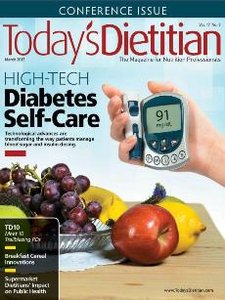
原文作者:Lynn Grieger,RD,CDE,cPT
发表于:Today’s Dietitian Vol. 11 No. 8 P. 12
作者简介:Lynn Grieger, RD, CDE, cPT, 是英国佛蒙特州的一位健康、食品和健身教练

糖尿病教育者经常与糖尿病患者谈论日常足部护理,但营养专业人员在预防和治疗这些人的伤口方面扮演什么角色?
据美国糖尿病协会(ADA)称,该疾病影响了近8%的美国人口,其患病率从2005年到2007年增加了13.5%。最佳糖尿病预防管理已被证明可以最大限度地降低视网膜病变、肾病及并发症、神经性疾病、缺血性心脏病、脑血管病和外周动脉疾病等的风险。大约60%至70%的糖尿病患者会出现某种类型的神经系统损害,包括四肢感觉受损。根据ADA的数据,超过60%的非创伤性下肢截肢术是针对糖尿病患者进行的,比无糖尿病患者高10倍。
糖尿病中经常发生的循环和神经损伤使得伤口愈合更加成问题,导致许多医生将糖尿病足伤口分类为世界上最常见的慢性伤口。根据2008年糖尿病预测的一篇文章,对于患有糖尿病的人来说,更令人恐惧的是,截肢者中有一半会在18个月内死亡,80%将无法存活5年。
根据南美Collins 博士,研究员,LD / N,FAPWCA,RD411.com的创始人兼执行董事以及营养和伤口护理的公认权威,糖尿病伤口护理没有基于证据的营养治疗指南。但我们可以使用针对其他类型伤口的研究和指南来推断适当的治疗,尤其是压力性溃疡。

美国国家压疮咨询小组(NPUAP)发布了一份关于营养在压力性溃疡预防和治疗中的作用的白皮书。根据白皮书,彻底的营养评估是最佳护理的起点,应包括体重状况、摄入热量、蛋白质、液体和维生素/矿物质、肾功能等[1,2]
糖尿病
糖尿病患者的伤口愈合的影响是复杂的,多因素的,并影响愈合的所有阶段。高血糖通过蛋白质的非酶糖化引起组织损伤。具有较长半衰期的蛋白质,例如胶原蛋白,纤维蛋白,白蛋白和血红蛋白,累积晚期糖基化终产物,其可导致微循环中基底膜增厚,导致缺血和伤口愈合受损。糖尿病伤口缺乏胰岛素导致蛋白质降解增加,胶原蛋白形成减少,影响身体愈合伤口的能力.[3]
由于碳水化合物是细胞的主要能量来源,包括那些参与伤口愈合的细胞,因高血糖引起的碳水化合物利用受损导致更多的蛋白质水解,糖原分解和脂肪分解以及随后伤口愈合能力降底。[3]
高血糖还会导致渗透性利尿和水和电解质的损失,通过减少组织氧合作用对伤口愈合产生负面影响.[3] 细胞外和细胞内脱水都会发生,损害皮肤愈合的能力.[4] 高血糖也会损害白细胞、巨噬细胞和免疫功能的作用,导致感染风险增加和伤口愈合能力下降。成纤维细胞功能、血管生成和胶原蛋白的产生对糖尿病患者伤口愈合受损有一定作用。高血糖还会增加自由基的产生,从而增加氧化应激, 导致组织损伤[4]. 不受控制的糖尿病对伤口护理的一系列影响使预防变得至关重要,需要最佳的营养护理来促进愈合。
医学营养治疗的目标
没有特别推荐最佳血糖或血红蛋白A1c水平来促进伤口愈合。根据糖尿病医疗保健标准,降低A1c至低于或约7%已被证明可以减少1型和2型糖尿病的微血管和神经病变并发症。如果没有针对血糖控制的特定指导方针来促进伤口愈合,那么将A1c设定为低于7%的目标是有意义的。
用于糖尿病患者伤口愈合的医学营养疗法(MNT)包括以下四个方面:
- 体重30至35千卡/千克,根据体重和伤口愈合的变化进行调整[1]:根据Collins的说法,卡路里摄入量是伤口愈合营养护理中最重要的组成部分。如果没有最佳的卡路里摄入量,蛋白质将无法促进伤口愈合,维生素和矿物质摄入量很可能不是最理想的。Collins解释说,伤口愈合本身是一种能量密集的合成代谢过程,需要最佳的卡路里摄入量。
- 1.25至1.5克蛋白质/千克体重,以实现正氮平衡:应定期评估肾功能,以确保适当的蛋白质摄入量。[1]
- 30毫升液体/千克体重,以防止脱水:体温升高、呕吐、大量出汗、腹泻或严重引流的伤口可能需要增加补充体液量。[1]
- 鼓励均衡饮食,满足人体每日摄取推荐量(RDA)的所有维生素和矿物质 [3] : Becky Dorner,RD,LD,Becky Dorner&Associates,Inc和营养咨询服务公司总裁以及NPUAP白皮书的合着者指出,没有研究值得支持更高剂量的维生素或矿物质。Collins同意但指出,由于这类研究的难度和费用,我们可能永远不会有基于证据的指导方针,提供促进伤口愈合的特定微量营养素建议。
在2008年美国饮食协会食品与营养会议暨博览会上发表的海报会议回顾了针对伤口愈合中精氨酸,维生素C,锌和蛋白质使用的对照试验。他们的分析发现没有研究表明补充维生素C/锌的临床效果,但蛋白质和精氨酸对伤口愈合有积极作用.[5]
可能需要补充营养补充剂以满足某些人的卡路里和蛋白质需求,并且可以包括自制的高蛋白/高热量奶昔或专门的商业配方,例如BOOST,Glucerna或类似产品。
精氨酸是一种氨基酸, 通常在体内以足够的数量产生。然而, 压力或疾病可能需要从饮食中增加精氨酸的数量。Collins 建议对精氨酸进行30天的试验, 以促进伤口愈合, 但他警告说, 摄入足够的热量和蛋白质必须是第一要务。处于边缘营养状态和摄入的患者将受益于多种维生素, 并可能受益于额外的锌和维生素 c.[1] 然而, 在糖尿病伤口中没有建立微量营养素补充指南。
优化营养护理的几点建议
wunds411. com 为营养专业人员和患者提供了各种营养教育材料, 包括皮肤和伤口营养指南, 其中概述了各种伤口的最佳热量、蛋白质、液体、维生素和矿物质阶段。据该网站介绍, 建议每天服用500毫克维生素C, 每天服用220mg硫酸锌三次, 最长持续两周, 同时提供最佳的卡路里和蛋白质摄入量。
Linda Ro,MS,RD / LD / LDN,在家庭医疗保健领域工作,经常看到患有足部溃疡的糖尿病患者。她建议采用以食物为主的蛋白质方案,鼓励增加牛奶、奶酪和花生酱的摄入量,以及大多数患者食用的肉类。由于难以从食物中获得最佳量的锌和维生素C,只要没有肾结石病史,她还建议(经医生批准)多种维生素加25毫克锌和500毫克额外维生素C。对于能够负担得起补充剂的患者,她可以使用Resource Arginaid,或者如果Arginaid不能负担得起,可以使用Ensure,BOOST,Slim-Fast或Carnation Instant Breakfast。
总结
营养专业人员从事糖尿病创伤的总结有三个方面:
1. 通过良好的血糖控制和健康的饮食进行预防;
2. 用最佳数量的热量、蛋白质、液体和维生素矿物质进行及时治疗;
3. 经常重新评估, 以调整营养护理计划, 以促进最佳的伤口愈合。
参考文献:
- Dorner B, Posthauer ME, Thomas D. The role of nutrition in pressure ulcer prevention and treatment: National Pressure Ulcer Advisory Panel white paper. Available at: http://www.npuap.org/Nutrition%20White%20Paper%20Website%20Version.pdf. Accessed May 24, 2009.
- Dorner B. New recommendations for treating pressure ulcers. Today’s Dietitian. 2009;11(5):14-16.
- Khan MN. The influence of diabetes on wound healing. The Diabetic Foot. Autumn 2005.
- Posthauer ME. Diet, diabetes, and wound management: How important is glycemic control? Holist Nurs Pract. 2004;18(6):318-320.
- Hill J, Landers P, Butcher J, Solnok H. Are wound care protocols evidence based? J Am Diet Assoc. 2008;108(9):A29.
英文原版
August 2009 Issue
Nutrition and Wound Care
By Lynn Grieger, RD, CDE, cPT
Today’s Dietitian
Vol. 11 No. 8 P. 12
Diabetes educators routinely talk to patients with diabetes about daily foot care, but what role do nutrition professionals play in preventing and treating wounds in these individuals?
According to the American Diabetes Association (ADA), the disease affects nearly 8% of the U.S. population, and its prevalence increased 13.5% from 2005 to 2007. Optimum diabetes management has been shown to minimize the risk of complications such as retinopathy, nephropathy, neuropathy, ischemic heart disease, cerebrovascular disease, and peripheral arterial disease. About 60% to 70% of people with diabetes have some type of nervous system damage that can include impaired sensation in the extremities. More than 60% of all nontraumatic lower limb amputations are performed on people with diabetes, a rate 10 times higher than for people without diabetes, according to the ADA.
The circulation and nerve damage that often occur in diabetes combine to make wound healing more problematic, leading many physicians to categorize diabetic foot wounds as the most common chronic wounds in the world. Even more frightening for people with diabetes, one half of amputees die within 18 months, and 80% won’t survive five years, according to a 2008 Diabetes Forecast article.
According to Nancy Collins, PhD, RD, LD/N, FAPWCA, founder and executive director of RD411.com and a recognized authority on nutrition and wound care, there are no evidence-based nutrition therapy guidelines for diabetic wound care. But we can extrapolate appropriate therapy using research and guidelines for other types of wounds, especially pressure ulcers.
The National Pressure Ulcer Advisory Panel (NPUAP) released a white paper on the role of nutrition in pressure ulcer prevention and treatment this year. According to the white paper, a thorough nutritional assessment is the starting point for optimum care and should include weight status; intake of calories, protein, fluid, and vitamins/minerals; and renal function.1,2
Wound Healing for People With Diabetes
Diabetes’ influence on wound healing is complex, multifactorial, and impacts all stages of healing. Hyperglycemia causes tissue damage through the nonenzymatic glycation of proteins. Proteins with a longer half-life, such as collagen, fibrin, albumin, and hemoglobin, accumulate advanced glycation end products, which can cause thickening of the basement membranes in microcirculation, leading to ischemia and impaired wound healing. A lack of insulin in diabetic wounds results in increased protein degradation and decreased collagen formation, impacting the body’s ability to heal the wound.3
Because carbohydrate is the primary energy source for cells, including those involved in wound healing, impaired utilization of carbohydrate due to hyperglycemia leads to more proteolysis, glycogenolysis, and lipolysis and subsequent decreased wound healing.3
Hyperglycemia also leads to osmotic diuresis and the loss of water and electrolytes, which negatively impact wound healing by decreasing tissue oxygenation.3 Both extracellular and intracelluar dehydration occurs, impairing the ability of the skin to heal.4 Hyperglycemia also impairs the action of white blood cells, macrophages, and immune function, leading to an increased risk of infection and decrease in wound healing ability. Defects of fibroblast function, angiogenesis, and collagen production play a role in impaired wound healing found in people with diabetes.3 Hyperglycemia also increases the production of free radicals, which increases oxidative stress and leads to tissue damage and cell death.4 This cascade of effects of uncontrolled diabetes on wound care makes prevention crucial and requires optimum nutrition care to promote healing.
Goal of Medical Nutrition Therapy
There is no specific recommendation for an optimal blood glucose or hemoglobin A1c level to promote wound healing. According to the 2009 Standards of Medical Care in Diabetes, lowering A1c to below or around 7% has been shown to reduce microvascular and neuropathic complications of type 1 and type 2 diabetes. Without specific guidelines for blood glucose control to promote wound healing, it makes sense to set a goal for A1c below 7%.
Medical nutrition therapy (MNT) for wound healing in people with diabetes includes the following four areas:
1. Thirty to 35 kcal/kg body weight, adjusted based on changes in weight and wound healing1: According to Collins, calorie intake is the most important component of nutrition care for wound healing. Without optimum calorie intake, protein will not be available to promote wound healing, and vitamin and mineral intake will most likely be suboptimal. Collins explains that wound healing itself is an energy-intensive, anabolic process that demands optimal calorie intake.
2. 1.25 to 1.5 g protein/kg body weight to achieve a positive nitrogen balance: Renal function should be regularly assessed to ensure appropriate protein intake.1
3. Thirty ml fluid/kg body weight to prevent dehydration: Increased amounts of fluids may be necessary with elevated temperature, vomiting, profuse sweating, diarrhea, or heavily draining wounds.1
4. Encourage a balanced diet that meets the RDA for all vitamins and minerals3: Becky Dorner, RD, LD, president of Becky Dorner & Associates, Inc and Nutrition Consulting Services, Inc and a coauthor of the NPUAP white paper, notes that there is no research to support higher doses of vitamins or minerals. Collins agrees but notes that we may never have evidence-based guidelines giving specific micronutrient recommendations to promote wound healing because of the difficulty and expense of this type of research.
A poster session presented at the 2008 American Dietetic Association Food & Nutrition Conference & Expo reviewed controlled trials focusing on arginine, vitamin C, zinc, and protein usage in wound healing. Their analysis found no studies that demonstrated the clinical effectiveness of supplementing with vitamin C and/or zinc but that protein and arginine had a positive effect on wound healing.5
Supplemental Nutrition
Supplements may be required to meet calorie and protein needs in some people and can include homemade high-protein/high-calorie shakes or specialized commercial formulas such as BOOST, Glucerna, or similar products.
Arginine is an amino acid normally produced in adequate amounts in the body. However, stress or illness may require increased amounts of arginine from the diet. Collins suggests a 30-day trial period of arginine to promote wound healing but warns that adequate calorie and protein intake must be the first priority. Patients with marginal nutrition status and intake will benefit from a multivitamin and possibly from additional zinc and vitamin C.1 However, there are no established guidelines for micronutrient supplementation in diabetic wounds.
Practical Suggestions for Optimum Nutrition Care
Wounds411.com has a variety of nutrition education materials for both nutrition professionals and patients, including guidelines for skin and wound nutrition that outline optimal amounts of calories, protein, fluids, vitamins, and minerals for various wound stages. Five hundred milligrams vitamin C given twice daily and 220 mg zinc sulfate given three times each day for up to two weeks, along with optimal calorie and protein intake, are suggested, according to the Web site.
Linda Ro, MS, RD/LD/LDN, works in home healthcare and routinely sees people with diabetes who have foot ulcers. She recommends a food-first program for protein, encouraging an increased intake of milk, cheese, and peanut butter in addition to the meat most of her patients consume. Since it’s difficult to obtain optimum amounts of zinc and vitamin C from foods, she also recommends (with physician approval) a multivitamin plus 25 mg zinc and 500 mg additional vitamin C as long as there is no history of kidney stones. For patients who can afford a supplement, she may use Resource Arginaid or, if Arginaid is not affordable, Ensure, BOOST, Slim-Fast, or Carnation Instant Breakfast.
Bottom Line
The bottom line for nutrition professionals who work with diabetic wounds is threefold: prevention with excellent blood glucose control and a healthy diet; prompt treatment with optimum amounts of calories, protein, fluids, and vitamins/minerals; and frequent reassessment to adjust the nutrition care plan to promote optimal wound healing.
如果本文对您有帮助,欢迎使用左边赞赏~
¥赞赏

评论